One Million Years B.C. on Blu-Ray—Because You Love Dinosaurs Too
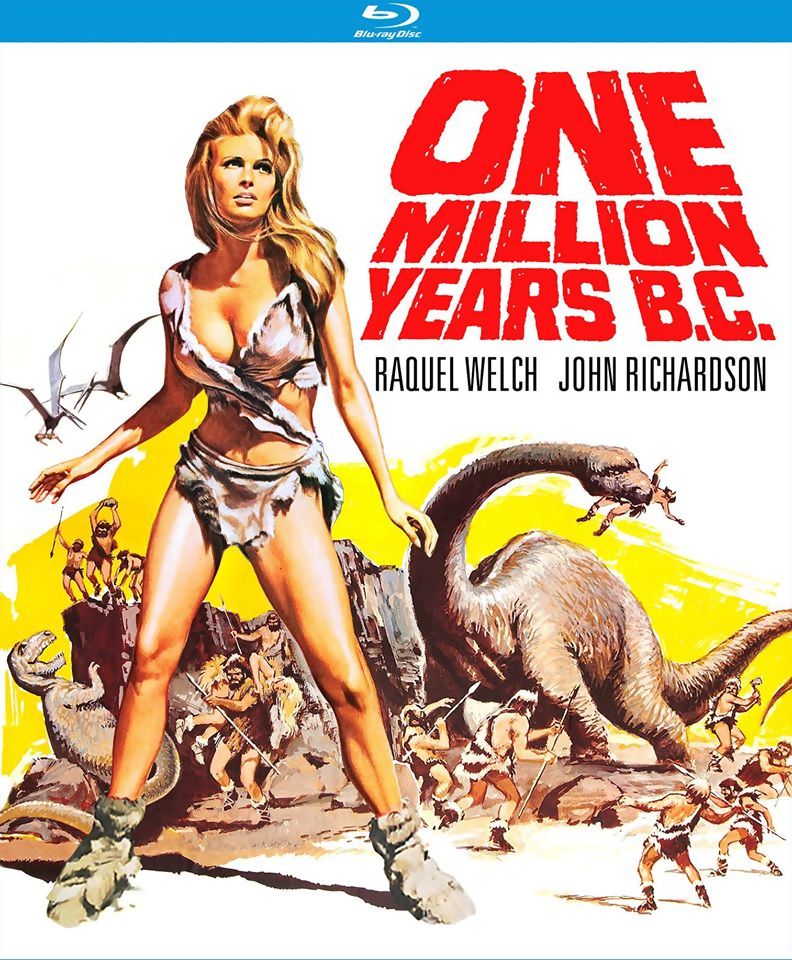 One Million Years B.C. was released this week on Region A (North America) Blu-ray for the first time, drawing us one step closer to a complete set of Ray Harryhausen movies on Hi-Def. We still need The Valley of Gwangi, which Warner Bros. owns — and they’re stingy about catalogue titles, especially if they’ve already released them as part of the Warner Archive MOD series. (Edit: Warner Archive is releasing a Blu-ray that will be out in a few weeks! So never mind. Thanks to Joe H. in the comments for pointing this out. Yes, there will be a review on March 18.)
One Million Years B.C. was released this week on Region A (North America) Blu-ray for the first time, drawing us one step closer to a complete set of Ray Harryhausen movies on Hi-Def. We still need The Valley of Gwangi, which Warner Bros. owns — and they’re stingy about catalogue titles, especially if they’ve already released them as part of the Warner Archive MOD series. (Edit: Warner Archive is releasing a Blu-ray that will be out in a few weeks! So never mind. Thanks to Joe H. in the comments for pointing this out. Yes, there will be a review on March 18.)
But no more of that. I’m here to celebrate the stop-motion dinosaurs of 1966’s One Million Years B.C., which is a crossover of two of my main movie loves: special effects wizard Ray Harryhausen and Britain’s Hammer Film Productions.
Hammer and Harryhausen
I once read a customer review on Amazon for the One Million Years B.C. DVD that remarked at the end, “If you’re buying this, you’re buying it for Raquel.” I wonder if the reviewer nodded off during stretches of the film and somehow failed to notice that there are dinosaurs all over it? Dinosaurs created by special effects legend Ray Harryhausen!
I’m not casting aspersions on the appeal of Raquel Welch; she has a enough screen presence to fill in a rock quarry and was a massive part of the movie’s marketing and initial global success. She adds a tremendous amount to the film and helps hold up the human action between stop-motion sequences. Yes, she is stunningly gorgeous on screen to the point that she almost seems unreal. But Raquel Welch has never been as popular as dinosaurs. Sorry, there’s no contest.
Let’s be honest: if One Million Years B.C. had no stop-motion Ray Harryhausen dinosaurs, it would be remembered today for the famous Raquel Welch image and that’s it. People wouldn’t still be watching the film or buying new releases of it more than fifty years later. The film itself would be a side-note, something discussed in terms of Welch’s career and popular 1960s sex symbols, but not anything viewers today would sit down to enjoy in full. Harryhausen’s effects make One Million Years B.C. a perennial.
For Hammer Film Productions, the movie was another way to stretch out their appeal and find new revenue streams away from their trademark Gothic horrors. For Ray Harryhausen, it was an assignment that briefly moved him from his partnership with Charles M. Schneer for a single movie so he could indulge in his dino-love. The experience inspired him to then make his own dinosaur film with Schneer afterwards, the fantastic (but financially unsuccessful) The Valley of Gwangi.
Based on One Million B.C., a silly 1940 Victor Mature and Carole Landis melodrama best known as a stock footage repository, One Million Years B.C. is a strange film in multiple wonderful ways. The prehistoric drama is a small and unstable movie subgenre that contains the Serious (Quest for Fire), the Stupid (10,000 B.C., The Clan of the Cave Bear), the Comic (The Croods, Caveman), and the Italian (Maciste against the Fire Monsters). One Million Years B.C. belongs to the most appealing variation: the one that willfully negates scientific sense to cram humans and dinosaurs into the same era. Five-year-olds know this is wrong, but if it means you get dinosaurs on screen, go nuts.
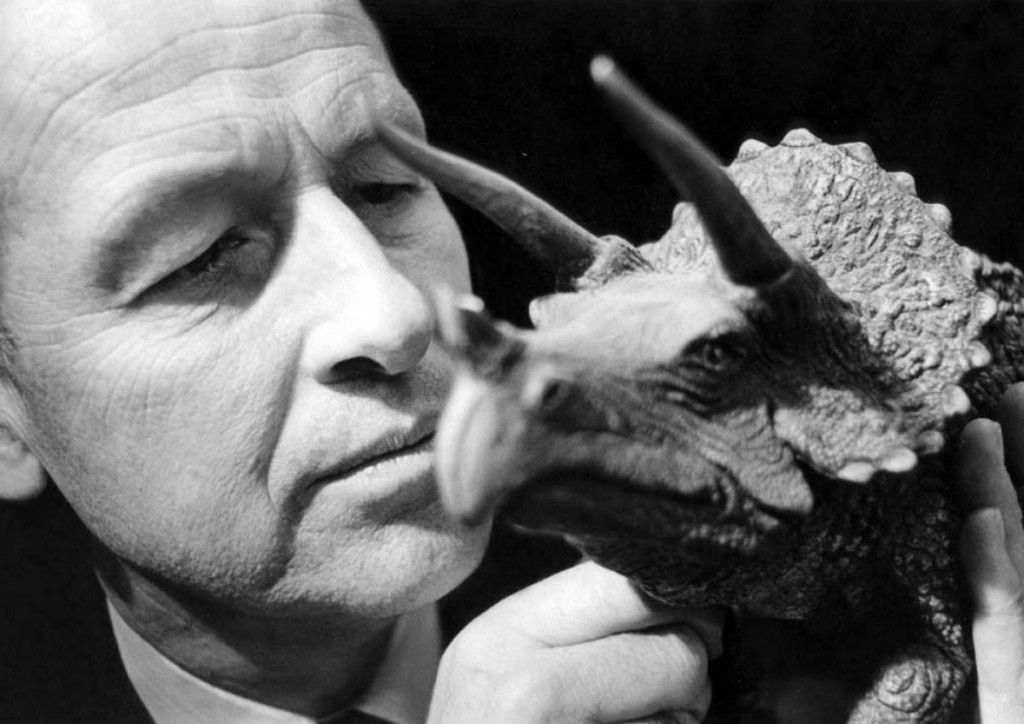 The mixture of humans and dinosaurs isn’t even the oddest thing about the movie. In an audacious move, there’s no dialogue in any understandable language. Aside from the sparse introduction from a narrator (an uncredited Vic Perrin, a member of the Hanna-Barbera voice acting bullpen), everything else in the tale of love between Tumak (John Richardson) and Loana (Welch) is spoken in the constructed languages of the Rock and Shell People. There’s also an eclectic score from Mario Nascimbene that melds percussive dissonance with choral and orchestral passages that sound as if they were composed for a Biblical epic. The location photography on the Canary Islands helps to create a truly out-of-time primitive aura.
The mixture of humans and dinosaurs isn’t even the oddest thing about the movie. In an audacious move, there’s no dialogue in any understandable language. Aside from the sparse introduction from a narrator (an uncredited Vic Perrin, a member of the Hanna-Barbera voice acting bullpen), everything else in the tale of love between Tumak (John Richardson) and Loana (Welch) is spoken in the constructed languages of the Rock and Shell People. There’s also an eclectic score from Mario Nascimbene that melds percussive dissonance with choral and orchestral passages that sound as if they were composed for a Biblical epic. The location photography on the Canary Islands helps to create a truly out-of-time primitive aura.
Seriously, Let’s Just Get to the Dinosaurs
But I’m not going to spend much time on the humans of One Million B.C. Or the music, photography, and whatever else a standard review usually contains. I’m here for Harryhausen and for the restored Blu-ray spectacle, so I’ll proceed through the movie by examining the special effects sequences in chronological order.
Big Boring Iguana
Ray Harryhausen would like to apologize that the first “dinosaur” appearing in the movie isn’t a stop-motion creation, but an actual iguana shot at high speed and integrated with the live-action. “At the time I felt that by using real creatures we might convince the viewers that all of what they were about to see was indeed real,” Harryhausen wrote in his autobiography, An Animated Life. “On reflection, it was an irrational mistake, if only because everyone picks up on the fact that there I was trying to get a real lizard to do tricks.” Bingo. The real iguana footage draws attention to the technique, rather than establishes verisimilitude. There’s also the problem that any film using blown-up footage of animals pretending to be giant monsters suffers, which is audiences know the scale of these creatures and can immediately sense the actual size of what’s on screen. An iguana is still an iguana, even when there’s a tiny John Richardson cowering before it.
The iguana also failed in its other job: saving time and money. The crew ended up shooting far more footage than expected because the iguanas simply fell asleep under the hot VFX lights. Getting them to do anything was frustrating — and the results simply weren’t worth all that effort.
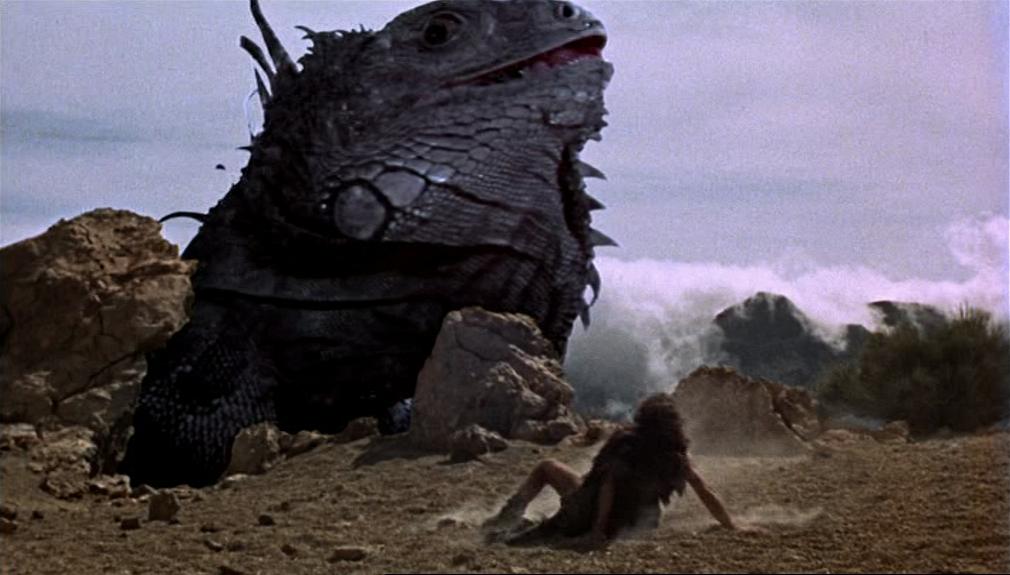 Brontosaurus Not Otherwise Appearing in This Film
Brontosaurus Not Otherwise Appearing in This Film
Any Ray Harryhausen movie has a few concepts for effects scenes that didn’t make it to final version, usually not advancing past the storyboarding stage. Captain Nemo was supposed to use a giant robotic digging machine in Mysterious Island, for example, and multiple ideas for The First Men in the Moon were canned because of difficulty with the anamorphic widescreen process.
One Million Years B.C. was supposed to have a sequence with a Brontosaurus as the climax. Some of it was shot for the background plates, but producer Michael Carreras vetoed the scene early because he thought it was one stop-motion sequence too many. (Come on, you can never have enough.) To salvage the work, the Brontosaurus makes a cameo in the desert for two shots. It does what it’s supposed to do, however, which is inform viewers that they’ll get more creatures this well-designed later in the film; the iguana was merely a fake-out.
Is That a Spider?
Yes, that’s a spider in one shot as Tumak crosses the desert. Not animated, just a real tarantula blown-up on film like the iguana. Harryhausen wanted this cut from the film because he thought it looked bad (it does), but Carreras insisted that it remain, so here it is. Forget you saw this and focus on the Brontosaurus. Better times are on the way.
The Archelon Wants You… To Kindly Move out of Its Way
At last, a full stop-motion scene! And it’s one where the “dinosaur” (technically, a large turtle is not a dinosaur, but let’s not split hairs) isn’t trying to threaten the humans — they’re simply in the path of it reaching the sea. It’s a good use of a non-aggressive animal for an action sequence. The archelon moves slowly, which allows for smooth animation work. The most impressive part of the set-piece, however, is the rocks and spears the Shell People hurl at the giant turtle, which carom off its head and shell to give a sense that the animal is real and in the same shot with the actors. This was done by matting out the spears and rocks after they contacted the model and replacing them with stop-motion miniatures. It’s almost seamless.
The only flaw in the scene is Loana shouting, “Archelon!” when she first sights the beast, somehow predicting its scientific name a few years early.
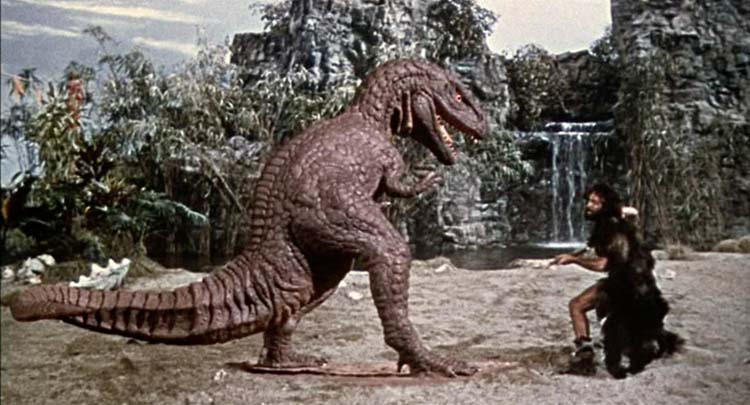 The Allosaur Is One of the Best Things Ever
The Allosaur Is One of the Best Things Ever
The movie’s essential set-piece, and one of Harryhausen’s finest achievements, is a juvenile Allosaurus attacking the Shell People’s camp. The smaller-sized predator looks forward to the use of raptors in later dinosaur films, allowing for dynamic choreography that pits humans against a carnivore closer to their size. There are numerous contact moments of the Allosaur fighting with the tribesmen, such as dragging them up from the lagoon with its mouth and pulling down a shelter around a few of them by ripping away the top with its jaws. Harryhausen allows for some camera “movement” when Tumak charges at the Allosaur against a moving backplate, creating an illusion of the camera on a dolly track following along. The closer with Tumak dead-dropping the Allosaur on a wooden pike is a corker of a climax to this highlight in dino-film history.
Ceratosaurus vs. Triceratops
Ever since Charles R. Knight painted a fresco of a Tyrannosaurus confronting a Triceratops, this type of battle of Cretaceous behemoths has been a staple of dinosaur mythology. One Million Years B.C. doesn’t let us down and offers up a Ceratosaur in a death-duel with a Triceratops. (In the 1940 film, this fight was between a lizard and a baby alligator. Inhumane and boring.)
This is the stop-motion scene that has the least to do with the humans; Loana and Tumak are trapped in a rock cleft while the dinosaurs fight to the death, giving us a chance to relax and simply enjoy pure stop-motion mastery. The scene remains in constant motion, particularly the Ceratosaur’s tail. This was no minor consideration, according to Harryhausen: “The tail is my favorite and one of the reasons I enjoy animating the large carnivorous dinosaurs. They have such wonderfully long tails with which to counterbalance their huge bodies.”
Pteranodon, Pterodactyl, and Mini-Raquel
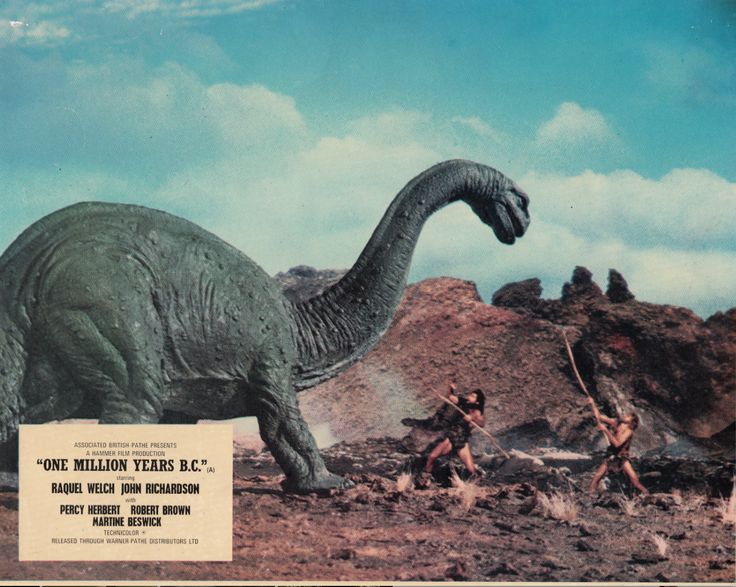 The sequence with the Pteranodon seizing Loana and then fighting over its find with a Pterodactyl is the weakest of the stop-motion sequences. This is due to the limitation of the technology, not Harryhausen’s abilities. The fast-flapping wings of the flying creatures, as well as their speedy motion when attacking each other, look jerky because there’s no motion blur; in each frame, the wings stay in clear focus. Later “go-motion” techniques such as used in Dragonslayer created a blur to overcome this issue. The obvious miniature used to replace Raquel Welch when the Pteranodon seizes her is also jarring. But there’s an effective on-location technique that helps out with the illusion, which is a wind machine on the sand and water to show the downdraft from the flapping wings. As with the Allosaurus scene, Harryhausen creates some sweeping illusions of camera movement that avoid the locked-down camera problems of stop-motion.
The sequence with the Pteranodon seizing Loana and then fighting over its find with a Pterodactyl is the weakest of the stop-motion sequences. This is due to the limitation of the technology, not Harryhausen’s abilities. The fast-flapping wings of the flying creatures, as well as their speedy motion when attacking each other, look jerky because there’s no motion blur; in each frame, the wings stay in clear focus. Later “go-motion” techniques such as used in Dragonslayer created a blur to overcome this issue. The obvious miniature used to replace Raquel Welch when the Pteranodon seizes her is also jarring. But there’s an effective on-location technique that helps out with the illusion, which is a wind machine on the sand and water to show the downdraft from the flapping wings. As with the Allosaurus scene, Harryhausen creates some sweeping illusions of camera movement that avoid the locked-down camera problems of stop-motion.
We Need a Closer: Volcano on Deck!
With the original Brontosaurus finale axed, Michael Carreras wrote in a volcanic eruption as the climax. I’d prefer a stop-motion creature, but this isn’t an awful alternative. The effects were done with a seven-foot model volcano shot at high speed that spews out a mixture of wallpaper paste, oatmeal, dry ice, and red dye. There are also fissures ripping open along the ground to add tension as the cave people scatter, and one of the rifts devours a stray iguana. These effects were done with miniatures and travelling mattes. The general chaos and sheer number of VFX shots makes for a satisfying close to the movie, even if the effects aren’t up to par with the rest of the film; the matte lines are too obvious, which wasn’t an issue in the earlier special effects scenes.
How’s the Blu-Ray?
The new Blu-ray comes courtesy of Kino Lorber, the same people who also provided special offerings to the gods with At the Earth’s Core and The Land That Time Forgot Blu-rays. There are two separate discs in the package with different cuts: the original U.K./International cut and an abbreviated one for U.S. distribution. The International cut runs eight minutes longer for a total of 100 minutes. Much of what was trimmed for the U.S. release is bits of violence to make the film more child-friendly. Here’s a detailed breakdown of the edits. Although it’s good that Kino Lorber offers both cuts, there’s no reason to watch the shorter one except for comparison.
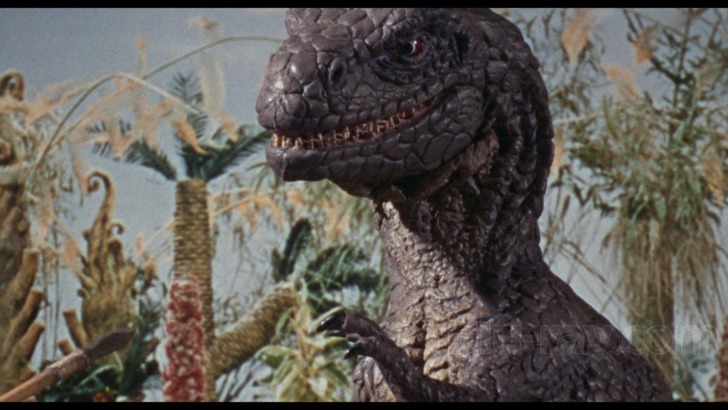 The back of the Blu-ray package advertises a new 4K Restoration “for the 91 minute U.S. cut,” but the transfer on both discs looks identical — and fantastic. The improvement over the previous DVDs is tremendous in detail, clarity, visual texture, and the removal of scratches and damage. The opening location shots of the Canary Islands are sumptuous; Wilkie Cooper’s cinematography, which enhances the feeling of the prehistoric setting, has never looked better. The stop-motion creatures also have a new beauty to them, even though it’s easier to notice tiny seams between the model and the production photography plates. It’s not often that I’m enormously impressed with the transfer of an older catalogue title, but the folks responsible for the restoration and transfer on this disc did exceptional work. There were points where I felt as if I were seeing the movie for the first time, even though it’s been part of my life since junior high school.
The back of the Blu-ray package advertises a new 4K Restoration “for the 91 minute U.S. cut,” but the transfer on both discs looks identical — and fantastic. The improvement over the previous DVDs is tremendous in detail, clarity, visual texture, and the removal of scratches and damage. The opening location shots of the Canary Islands are sumptuous; Wilkie Cooper’s cinematography, which enhances the feeling of the prehistoric setting, has never looked better. The stop-motion creatures also have a new beauty to them, even though it’s easier to notice tiny seams between the model and the production photography plates. It’s not often that I’m enormously impressed with the transfer of an older catalogue title, but the folks responsible for the restoration and transfer on this disc did exceptional work. There were points where I felt as if I were seeing the movie for the first time, even though it’s been part of my life since junior high school.
The bonus features include three interviews: Raquel Welch and Ray Harryhausen (both done for Blue Underground in 2002) and a more recent sit-down with actress Martine Beswick, who plays Loana’s competition for Tumak’s affections. Harryhausen is his usual pleasant and sonorously-spoken self, and he shows off some of the surviving creature models from the film. If you’re already a fan of Harryhausen you won’t learn anything new here, but the late great effects wizard is always a pleasure to listen to. Welch’s interview is brutally honest: she’s always disliked the film (“silly dinosaur movie”) even though she knows it made her career. She talks about the difficulties of the location shoot, and how a single image the unit photographer took of her transformed her into a sex symbol overnight — and she didn’t know what to make of it all.
The Beswick interview is the best of the three: I’ve seen many interviews with her regarding James Bond and Hammer movies, and she’s consistently an exciting storyteller. Unlike Raquel Welch, she loved her time spent on One Million Years B.C. and sounds like she’s an unabashed Harryhausen fan. She closes the segment with her anecdote of how she and co-star John Richardson fell in literal love at first sight on the production (they married a year later). She’s so animated when she speaks of it that you can tell it was the most exciting time of her life.
Ryan Harvey is one of the original bloggers for Black Gate, starting in 2008. He received the Writers of the Future Award for his short story “An Acolyte of Black Spires,” and his stories “The Sorrowless Thief” and “Stand at Dubun-Geb” are available in Black Gate online fiction. A further Ahn-Tarqa adventure, “Farewell to Tyrn”, is currently available as an e-book. Ryan lives in Costa Mesa, California where he works as a professional writer for a marketing company. Occasionally, people ask him to talk about Edgar Rice Burroughs or Godzilla in interviews.
Actually, Gwangi just got announced for Blu-ray, and will be out in about three weeks! So I think that’s the complete Harryhausen catalog, except for The Animal World and a few random shorts that showed up on some of the documentaries.
https://www.amazon.com/Blu-ray-Franciscus-Richard-Laurence-Naismith/dp/B01LTIB7YE/ref=sr_1_1_twi_blu_2?ie=UTF8&qid=1487431637&sr=8-1&keywords=valley+of+gwangi
@Joe – Wow, that managed to sneak in while I wasn’t looking. Anyway, made the update. And of course I now have a new Blu-ray to review in a few weeks!
Oh YES! One of my favorite guilty-pleasure movies (although can it really even be called a guilty pleasure, as great as it is?).
Love your review. We’re totally in sync. I read this line: “Yes, she is stunningly gorgeous on screen to the point that she almost seems unreal. But Raquel Welch has never been as popular as dinosaurs. Sorry, there’s no contest.” And I thought to myself, Yeah, I enjoy every inch of Raquel Welch in this flick, but if you took away the dinosaurs would I own it? No. And if the film had everything but Raquel, would I still own it? Almost certainly yes.
And then I read on, and in the very next paragraph you make the exact same point. So, it turns out, I have nothing to add!
Except now I want to get this on blu-ray (and I’m all over The Valley of Gwangi when that drops. I have a six-year-old son who is way into dinosaurs, and I know he’ll love both of these. (Yeah, he watches the new CGI stuff, but he loves the old-school just as much, with this caveat: he’s always asking me to skip ahead to the next scene of Godzilla or King Kong or Gamera or whoever has top billing to tear up stuff in that particular flick).
@Nick – Yes, I don’t think you can all this a guilty pleasure when there’s so much that is genuinely great about it. The Blu-ray really brings out how good the film looks, the astonishing locations and Cooper’s photography, which elevates everything. I understand people thinking the film is “silly,” and sure there are silly qualities, but my enjoyment of it isn’t in any way ironic. The dino scenes are among the best prehistoric monster scenes every done.
Yep — I had actually tweeted to Warner Archive about Gwangi Blu-ray a couple of days prior, their response was, “Hmmm … Something to consider …”, and then the announcement dropped like the next day.
@Joe – I’m going to switch over to “Complain about [insert movie title] not being on Blu-ray!” as my model for all my Black Gate posts from now on — because I’ve managed to get these things wrong a few times before. (It happened with The Rocketeer a few years ago.) Maybe I can make these things happen by reverse engineering predictions.
So in that vein: “Why are there no plans to release a Region A Blu-ray of Warlords of Atlantis?” [Prove me wrong, somebody!]
I like it! Could we also complain about the absence of Hearts & Armour in _any_ non-VHS format?
@Joe – So many Italian genre films haven’t made it to any decent format in North America. It’s a plague. I still can’t believe there’s no anamorphic release of any kind of The Great Silence, which is probably the best Italian Western after Leone’s films. There’s an old and long out-of-production DVD that’s non-anamorphic and only has the English dub.
[…] ‘never mind Raquel’ and squeeing over the dinosaurs instead is hilarious.” Ryan Harvey, “One Million Years B.C. on Blu-Ray—Because You Love Dinosaurs Too” at Black […]